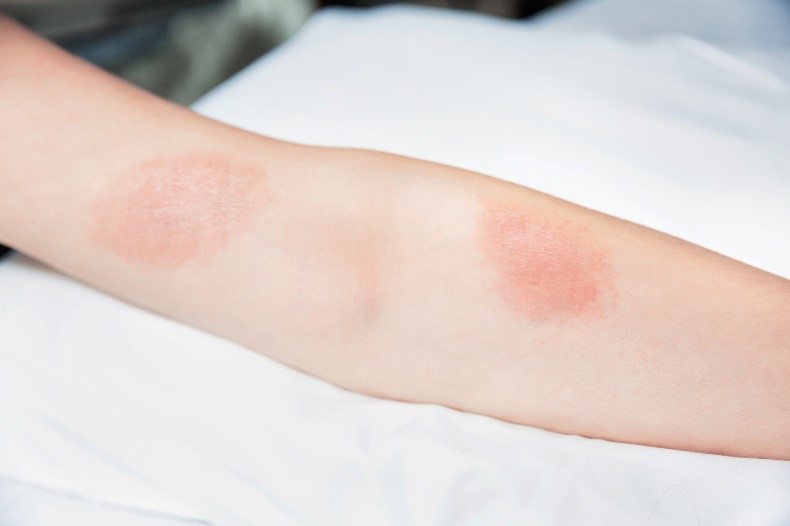Know Your Poison Ivy, Oak and Sumac

Whether you’re walking a trail in the woods, trimming brush in your backyard, or pitching a tent in one of Oklahoma’s best campgrounds, you may come across poison ivy this summer – and before you know it, you might be sporting a red, itchy rash. Poison ivy is the most common allergic reaction in the U.S. and affects as many as 50 million Americans each year.
The best way to avoid poison ivy is to recognize it when you see it. This poison vine can be hard to spot because it not only climbs trees, it can also grow on the ground and can blend in with normal foliage. Here’s how to identify poison ivy, oak and sumac so you can avoid all of them!
How to identify poison ivy
The poisonous part of poison ivy is actually an oil called urushiol found inside the plant. It can become exposed on any plant that has been damaged, bruised, cut or crushed. Even the smallest amount of damage to the plant, such as walking through a patch, can cause the oil to seep out.
A good rule of thumb is to remember the famous saying, “Leaflets of three, let it be.” Poison ivy leaves are compound leaves, meaning each leaf is composed of three leaflets. In each set of leaflets, the middle leaflet has a longer stem than the two side leaflets. Often, a poison ivy leaf has a reddish stem, and the leaflets follow a distinctive, alternating pattern.
Be sure and check the vine. Thick, hairy vines are a hallmark of poison ivy plants.
Finally, look for berries. Poison ivy vines will sprout small, opaque, white or yellowish berries that look like tiny pumpkins.
Poison ivy look-alikes
These look-alikes are often mistaken for poison ivy, but there are notable differences.
Virginia creeper – Virginia creeper ivy is a well-known poison ivy look-alike. While both plants are vines, they can be distinguished by their leaves. Poison ivy has three leaflets while Virginia creeper has five.
Virginia creeper vines are thick like poison ivy vines, but will be covered in light-colored tendrils rather than rough hair. The berries of a Virginia creeper are blue-black, not opaque white or yellowish like poison ivy berries.
Boxelder – Boxelder is in the maple family. Young seedlings of the boxelder tree superficially resemble poison ivy, with three leaflets, but boxelder seedlings grow to become leaves with three to seven leaflets. Also, boxelder leaflets are arranged on the stem opposite from each other, not alternatively like poison ivy.
Boxelder has yellow fall color, lacks the hairy aerial rootlets of poison ivy and does not have berries.
Other poisonous plants in Oklahoma
Unfortunately, besides poison ivy, you can also find poison oak and poison sumac plants in areas of Oklahoma.
- In most of the state, you will find eastern poison ivy, as it’s the most common.
- In eastern Oklahoma, Atlantic poison oak is commonly found.
- Poison sumac is only found at the very edge of the southeastern border of Oklahoma.
Feeling a little confused about the three? Here’s the difference:
Poison ivy – This vine is found on the ground, climbing on trees, fences, and walls, and can also be found in small shrubs. Poison ivy always comes with three leaves and never has thorns or sharp or scalloped edges.
Poison oak – Poison oak is not as common as poison ivy in Oklahoma. However, it is hard to tell the difference between the two and most people use the term ivy and oak interchangeably.
Poison sumac – You may only run into poison sumac if you are traveling south. Poison sumac looks a lot different than poison ivy, as its only form is a small tree. Poison sumac thrives in wetland areas.
How to treat poison ivy
The itchy rash caused by poison ivy often does not appear until 12 to 72 hours after you’ve been exposed to the oil.
If you break out into a serious rash or if you experience swelling or blistering with the rash, it’s best to visit your health care provider right away.
If your rash is minor, here are some tips from the American Academy of Dermatology.
- Wash the affected areas with soapy, lukewarm water.
- Place cool, wet compresses on the affected area for 15 to 30 minutes several times a day.
- Soak in a cool-water bath containing an oatmeal-based bath product such as Aveeno.
- Apply an over-the-counter corticosteroid cream for the first few days.
- Apply calamine lotion.
- Take oral antihistamines, such as diphenhydramine (Benadryl, others), which may also help you sleep better.
- Wash any belongings that might have come into contact with the ivy to prevent further outbreaks.
Hopefully, you can help share your new knowledge of poison ivy in Oklahoma and save someone you love from an itchy, uncomfortable rash. Want more Oklahoma outdoor tips? Read our articles about Snakes in Oklahoma and Hiking Safety Tips to Enjoy the Great Outdoors.



